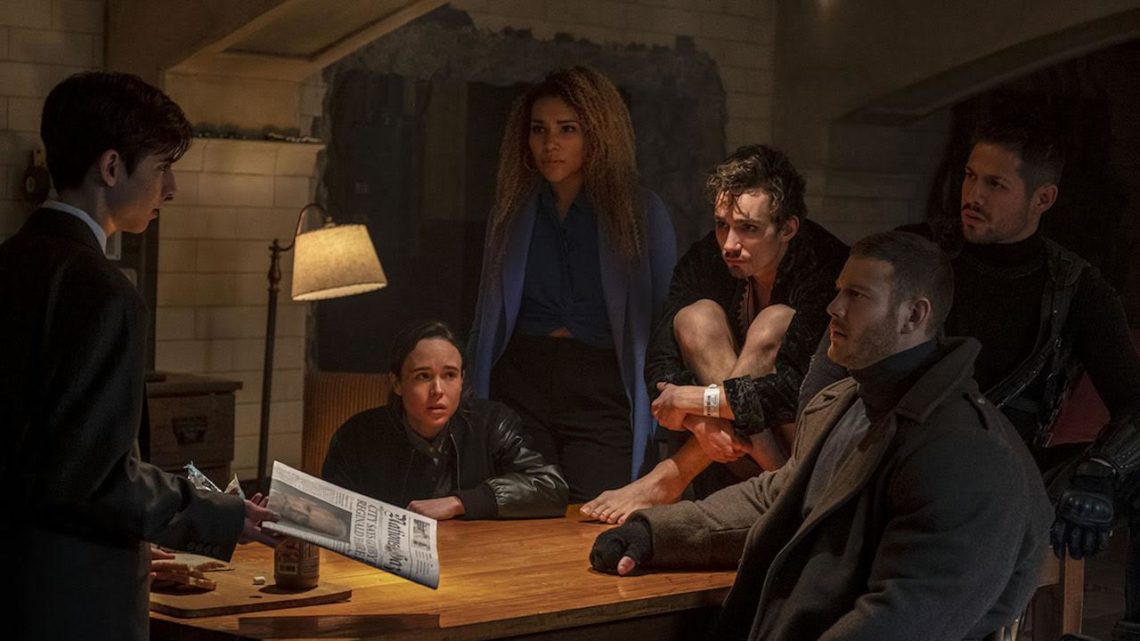Zoe Glasser and Alexis Larsen
How do you make a superhero story unique? For The Umbrella Academy, the answer is to create a dysfunctional superpowered family, time-traveling assassins, and an impending apocalypse.
The Umbrella Academy was originally a comic book created by former My Chemical Romance frontman Gerard Way and illustrated by Gabriel Bá. It was first published in 2007 and has since achieved cult status among comic enthusiasts. In 2018, it was announced that streaming giant Netflix had greenlit the production of a live-action first season, which debuted on February 15, 2019.
The story follows a dysfunctional family of seven siblings whose eccentric billionaire father, Reginald Hargreeves, adopted them from across the world. Luther (Tom Hopper) is the leader of the team, and boasts super strength; Diego (David Castañeda) is a hotheaded vigilante with superb aim; Allison (Emmy Raver-Lampman) is an A-list movie star with the power of persuasion; Klaus (Robert Sheehan) is a drug-addled kleptomaniac who can speak to the dead; and Vanya (Ellen Page) is an ever-excluded and seemingly ordinary violinist. Two members of the Academy are missing: Number Five (Aidan Gallagher), with the ability to teleport throughout time and space, mysteriously disappeared seventeen years ago, and Ben (Justin H. Min) who could unleash tentacles from his stomach, died tragically as a child. The estranged family is brought together by their father’s death in the first episode, when Number Five reappears, claiming that the apocalypse will occur in eight days.
Meanwhile, Number Five is pursued by Hazel (Cameron Britton) and Cha Cha (Mary J. Blige), two time-traveling assassins. When first introduced, the duo seemed to be the main antagonists who wore colorful cartoon masks during each mission, but it is quickly revealed that they were receiving orders from a higher power.
The 15-year-old Aidan Gallagher faced the toughest role in the cast, playing a 58-year-old trapped in a 13-year-old’s body. His sardonic and egotistical attitude is both compelling and hilarious, and his interactions with the other characters always make for a plot revelation or an instance of comedic relief.
The ten-episode series excelled where many Netflix originals struggle: it gave each character meaningful development without rushing the plot. The show gives characters such as the addictive, chaotic Klaus a purpose and reason for his actions and behaviors.
The soundtrack was largely influenced by Way and his love for 20th-century music. The track list includes Saturday Night by Bay City Rollers, Don’t Stop Me Now by Queen, I Think We’re Alone Now by Tiffany, Dancing in the Moonlight by Toploader, and One by Three Dog Night. The track list also includes Hazy Shade of Winter by Simon and Garfunkel and Happy Together by The Turtles, both of which were covered by Way and featuring former My Chemical Romance guitarist Ray Toro. Each song was placed perfectly in an episode, making memorable and breathtaking scenes. The use of Istanbul (Not Constantinople) by They Might Be Giants during a fight sequence between Five and antagonists Hazel and Cha Cha was placed brilliantly, changing the entire mood of the scene.
The series made major changes of the source material in that the cast of the series was far more diverse than that of the comic. Since each of the Hargreeves children were theoretically born all over the world, Way wanted to display this in the casting of the show. This choice translated excellently onto the small screen and showed that everyone can be a superhero, regardless of origins and experiences.
Overall, the cinematography, acting, and soundtrack meshed together beautifully and led to a creative and refreshing take on a common trope. Sometimes the plot can be a bit predictable, but the originality of the concept counterbalances this. The series is extremely binge-able due to its frequent cliff-hangers, and is recommended for anyone above the age of 14.



